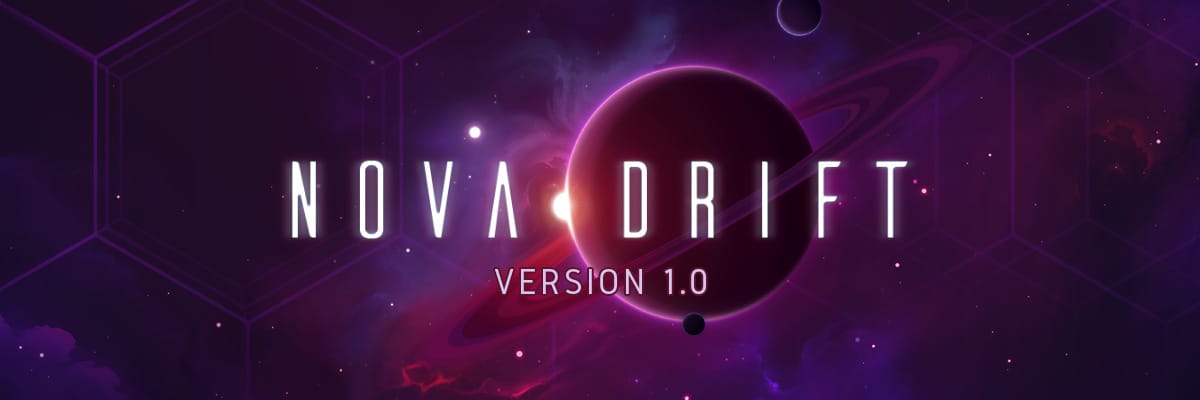
Early Access has finally ended! Nova Drift 1.0 is now available on Steam, Itch, novadrift.io, and Nexus stores!
New Features
- Added a final boss(!)
- Added the game ending sequence, which you will encounter if the Endless challenge mode is disabled
- Endless Mode can now be turned off, and unlocks when you first beat the game's final boss for the first time
- Added new sound effects and 4 new background music tracks, completing the OST
- Added the ability to override body and drone artwork with custom skins. Added 3 sets of custom skins. Players may also create and play with their own!
- Added German localization
- Added new settings including Assist Mode, and High-Visibility mode
- Implemented texture compression, significantly improving performance!
- Implemented several hundred balance changes, bug fixes, and quality of life improvements
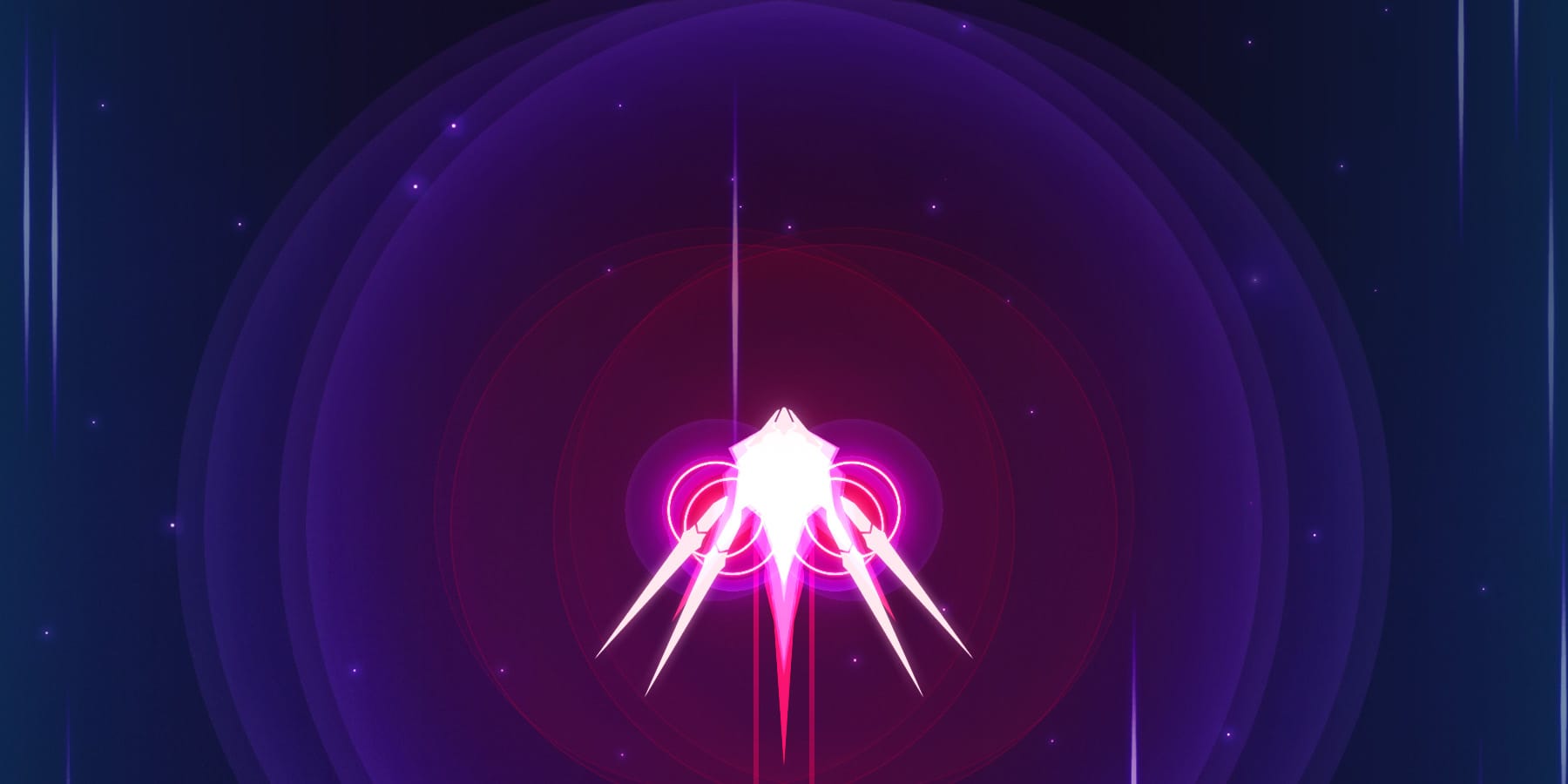
Notable Changes Include:
- Improvements/buffs to several Gear upgrades, including Research, Pulse, Blades, and Siphon
- Improvements/buffs to many Mods, including Rapid Reconstruction, Deadly Wake, Homing Strike, Mines, Allies, Firing Array, Charged Shot, Flash Shielding, Construct Specialist Wild Mods, and Transmogrification
- Improvements/buffs to several Super Mods, including Celestial Surge, Singular Strike, Sanctuary, Antimatter Rounds, and Ataraxia
- Improved boss, enemy and hazard behavior, including asteroids, comets, Scion, Glaucus, Warbringer, Bolt-Throwers, Juggernauts, and Hives
- Improved GUI, controls, menus, stats, text clarity, and the save system

Complete List of Changes
https://blog.novadrift.io/patch-notes/
Nova Drift Retrospective
I'll be writing a proper postmortem later, but I find I want to reflect on the game's development now, both to express my gratitude to everyone involved, and because I think it's been unorthodox enough that it may be interesting to players and useful to other game developers. I'm also writing to gain some closure and catharsis; It's been a long road. This will be quite long and personal, so if you're here for it, great, otherwise you could skip to the end if you just want to find out what's next for Chimeric and Nova Drift.
The Initial Nova Drift Pitch
Nova Drift was originally pitched more than a decade ago, in 2013, for a client who ran a web portal called Dojo. The request was to create an HTML5 game that would take 3 months(!) to make. I came up with a few simple pitches, Nova Drift being one of them.
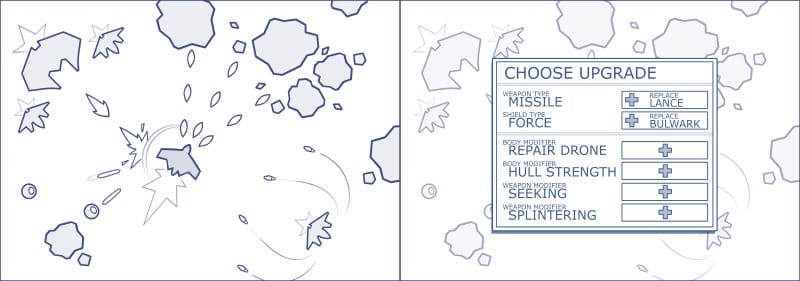
At the time, I was playing a ton of Path of Exile, which was by far Nova Drift's strongest influence. I wanted to explore ways to distill the experience of that game's hundred-hour character building into quick game sessions. Remember, this was more than a decade ago, we didn't have the scores of fast paced rogue-likes exploring that design space like we do today.
At this point in my life, I'd just quit corporate game development in favor of working in a more official capacity with Pixeljam, a tiny indie company who I had a ton of admiration for, and who had already become like mentors to me. This appealed to me greatly because I'd become fed up with corporate game culture and I was determined to solve this by working as small and as honestly as possible. For Nova Drift, I knew this meant reducing scope as much as I could while still retaining the mechanical complexity that defined it. In exploring this, I became so excited about building the game that I decided I would make it whether or not our client accepted it.
They passed on the pitch (thank goodness!) in favor of another one of my designs, Last Horizon, which Pixeljam and I developed as partners. Coming from an entirely art-focused background, Last Horizon served as my crash-course in coding. For the first time ever, I didn't make artwork on a project I was working on. Seeing its potential on mobile devices, it was expanded from a 3 month web-jam into a 1 year project.
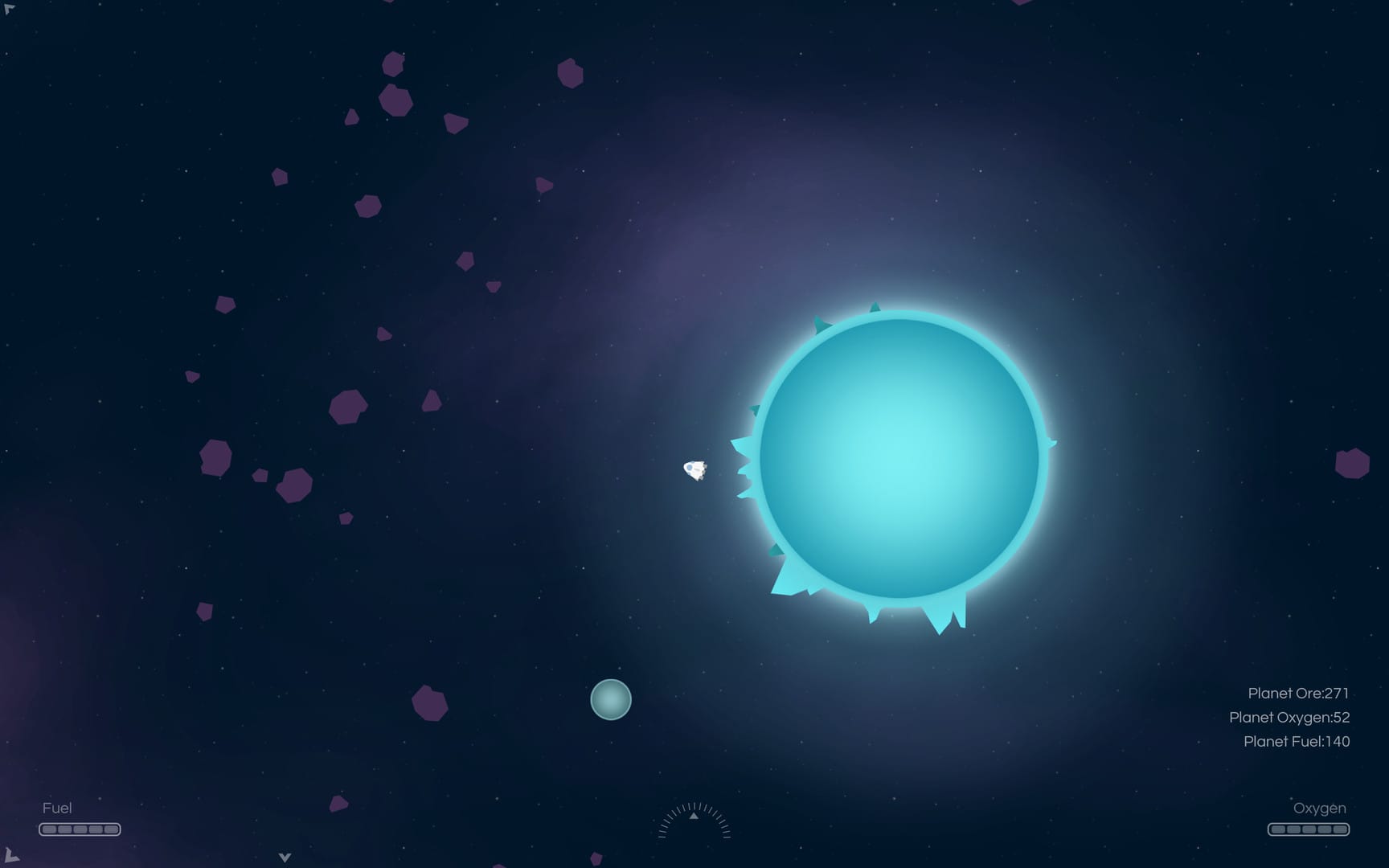
While Last Horizon was being developed, I planned to chip away at the prototype for Nova Drift just to maintain the momentum I'd had on it. In reality, I didn't have much time for it, but I couldn't stop thinking about it.
I finally managed to get Last Horizon to a presentable state, but as my first commercial programming project, it was a nightmare. With no formal training in programming or computer science, and using an engine that none of my coworkers were familiar with, I was on my own for every technical challenge. While it was rough, in retrospect, making this game allowed me an alternative to going back to college for programming. I also learned the importance of work life balance, and the game ended up doing very well on mobile, funding all of Nova Drift's early development.
Chimeric & Pixeljam
With Last Horizon shipped, I was finally free to jam on Nova Drift. Unlike the previous games I'd worked on, this wouldn't be a Pixeljam title, it would be self-directed. I formed my company and called it "Chimeric". By this point, Pixeljam had become what you might call a "micro-publisher". With micro-publishers you might trade the clout, up-front cash, and marketing power that bigger organizations can offer for a small team that acts more like a personal, experienced advocate and cheerleader. I'd heard the horror stories about all the constraints and pitfalls that could come with large publishers, and I didn't want to owe any money, so this suited me just fine. Besides, Pixeljam's Miles and Rich had been my friends and partners for years. Publishing would be Miles' area, and I knew that he would always have my back, and that he would always put my well being, and the quality of the game, before profit or deadlines (And he has). I signed on with them, and with Pixeljam in my corner, I was ecstatic to begin.
The Nova Drift First Playable
The first stages of a game project are always the best this was especially true with Nova Drift. I wanted to do nothing else, and would work late into the night simply because I enjoyed it. The prototype was immediately fun. I now realize that this is very rare, and it's never been true for any of the other several dozen games I've worked on, professionally or otherwise. I think this was due to the combination of a tried-and-true super-minimal core loop that could be implemented in a day along with the fact that new features were so modular that they were a breeze to stack on top of each other. In other projects, I've had to work hard and keep faith that I would eventually "find the fun". In a lot of prototypes, you never do, and that's just part of the process.
I took my awesome morale as a sign that I had something really worthwhile, and that pushed me through the anxiety that comes with forming your own enterprise. At first, I focused solely on making the basic shooting and movement as fun as I possibly could. I knew that if it could feel fantastic with only the most basic gear, every enemy and upgrade I stacked on top of it would be more of a good thing. This seemed to work, so I committed to the strategy. The game didn't need levels or a campaign, those would be distractions to the singular goal of making the best possible super-concentrated character building arcade game. To this end, I settled on simple arena combat with procedurally generated encounters.
The first playable versions of the game contained placeholder artwork. While it was refined and stylized over time, its roots of flat-colored geometric shapes remained.
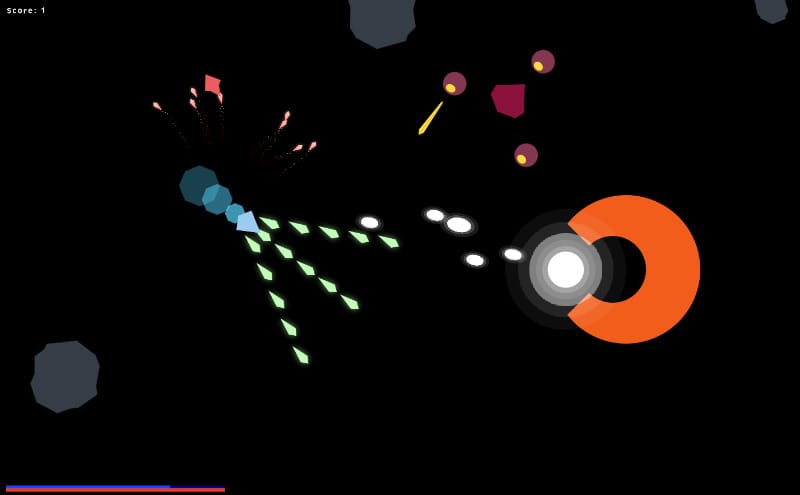
Nova Drift Alpha: Iteration and Exploration
Alpha lasted about four years. In that time I mostly piled on enemies and player upgrades until building felt diverse enough, while incrementally experimenting with the presentation.
The first attempt at an art overhaul retained the bold color treatment but introduced more complex forms and negative-space line art, and the menus also followed suit. I felt like this was a step in the right direction, but something about it still appeared immature to me.

The upgrade interface changed often. At first, the mod pool didn't contain any progression. This quickly revealed itself as problematic: In order to have the depth I wanted, the game needed a lot of mods. However, the game also had to remain accessible, unlike its Action-RPG influences. Too many mods meant too much info dumped on a player all at once. It also meant that the player's build would be mostly left to chance. I didn't want that, especially because The Binding of Isaac (the most popular Rogue-like at the time) had already thoroughly explored that.

The answer ended up being the mini-trees and Super Mod combos that are present in the game, now. While not a perfect solution, they provided a middle-ground between deterministic building and rogue-like randomness.
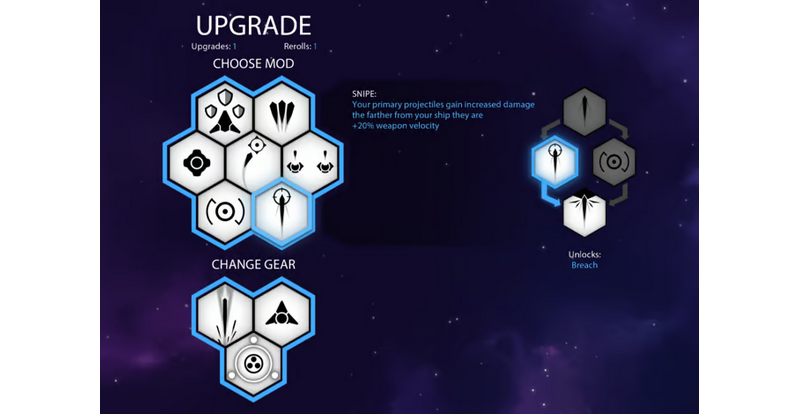
With the third re-imagining of the art treatment, I discovered that portraying the entities in neon resulted in a more modern look that at the same time represented its retro arcade roots. This also provided greater contrast which granted the freedom to paint detailed celestial backgrounds.
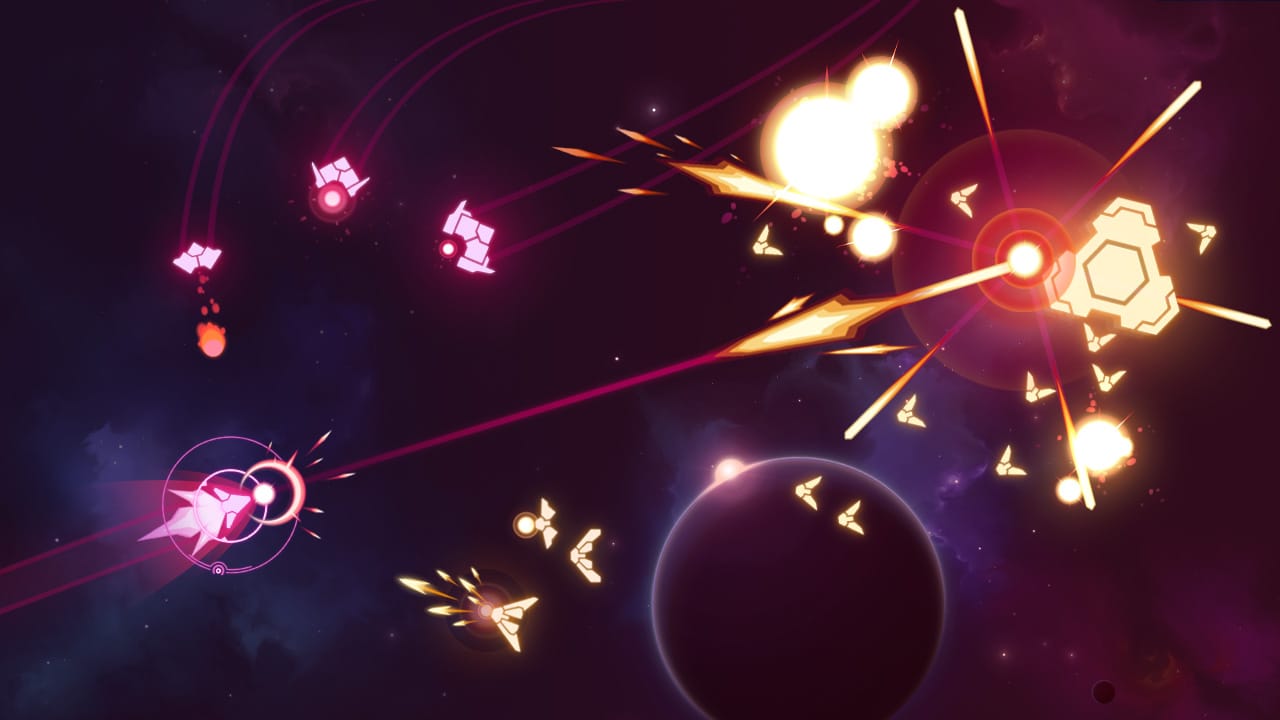
The complexity of the characters and GUI continued to increase over time, but for the most part this treatment is still represented in the final game.
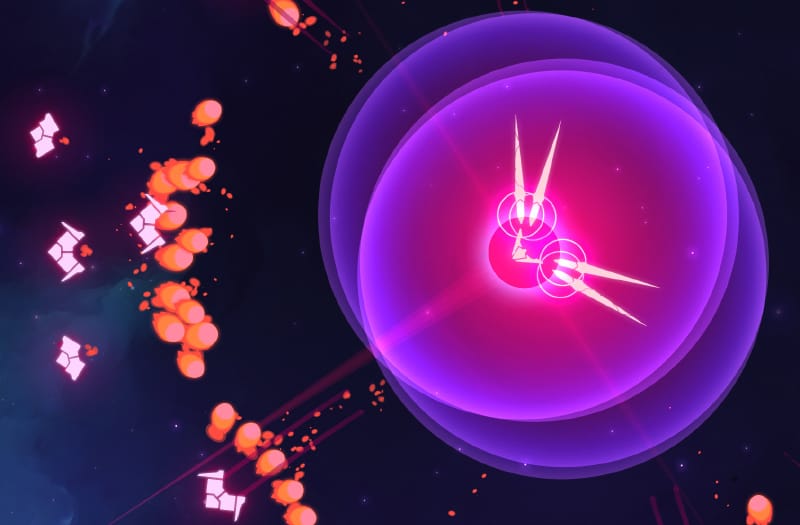
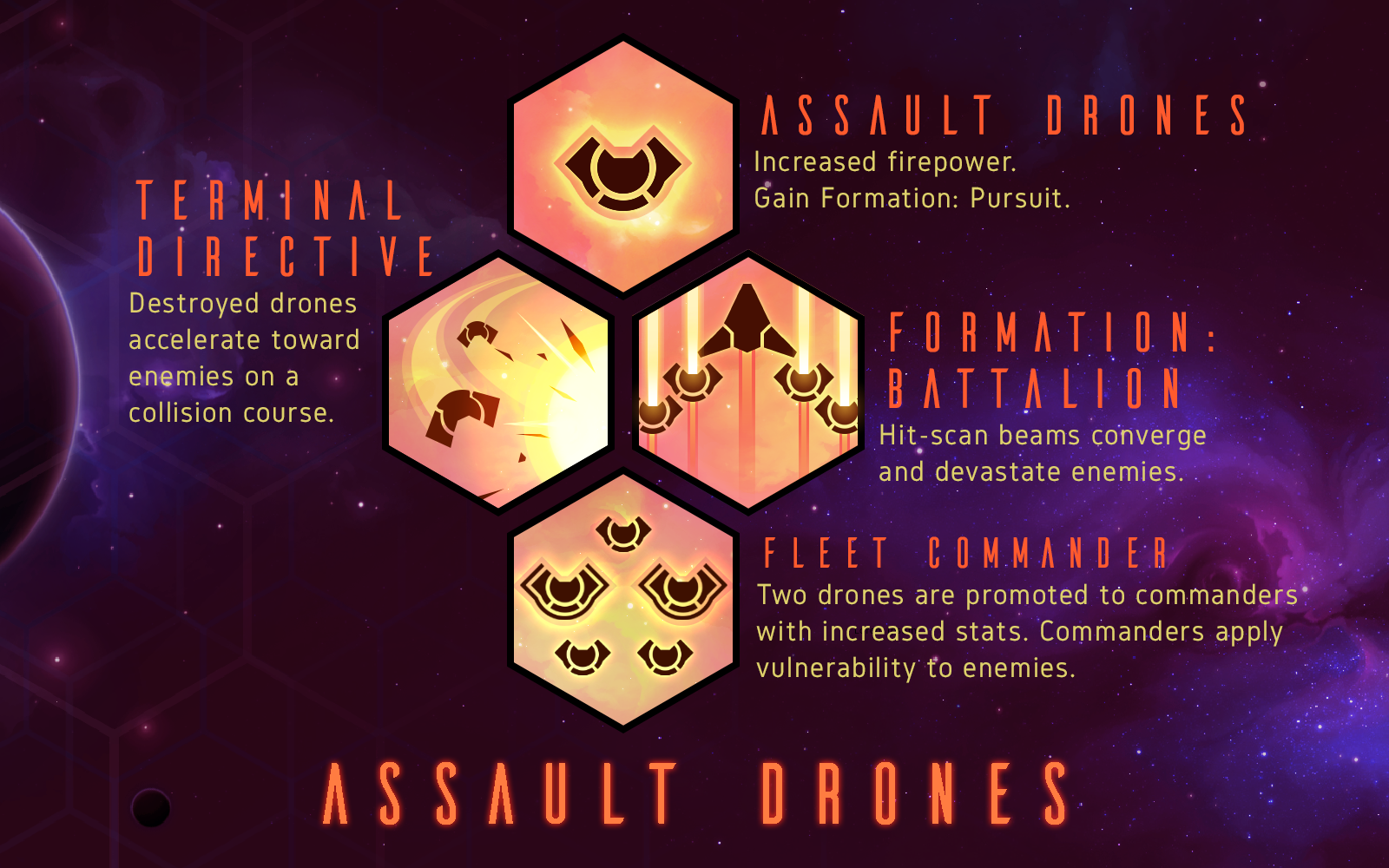
The Kickstarter
In 2017 it was almost time to make the game public. By then, that early momentum was starting to wear off. The game was becoming more complex and the introduction of the first real deadline made it harder to retain the super positive mental state I'd previously had. It wasn't just me messing around and finding out what I could do anymore– I'd gone all in– there were about to be financial stakes and other people to make happy. I'd also been developing alone for quite some time. Without player feedback coming in, development became an act of faith. I was adding things every day, but was the game really any good? How could I be sure? I learned that three years is a long time to work in a vacuum. It was time to get the game into the hands of players.
Since I had savings from my previous game development work and Last Horizon, Pixeljam and I created the Kickstarter with the modest goal of raising enough money for Miles to create the game's soundtrack (one of his many talents) and to gauge the amount of interest in the game. It performed about as well as we expected, not impressive, but not a failure, either. However, its never been easy to make it big on Kickstarter, and it turned out that the tangential benefits of running the campaign vastly outweighed the monetary value. The backers that put their faith in the game became the seed community that would become an indispensable part of development.
Nova Drift Beta: Early Access Begins
The positive feedback from the Kickstarter backers quickly galvanized me, inspiring a level of energy I hadn't felt since prototyping. I wasn't in the dark anymore. As game updates became Kickstarter newsletters, I continuously invited players to join the Discord I'd created for the game. I updated the game very frequently for two years. People started to become regulars, and I fell into a routine of involving them in balance and content discussions.
Miles and I started putting effort into getting eyes on the game for the upcoming early access debut on Steam and we were both surprised by our success! I wrote a blog post that detailed Path of Exile's influence on my game and posted it on their subreddit. The post garnered praise from the game's co-founder and game director, and got the attention of a decent chunk of the game's audience. The post would later lead to the streamer ZiggyD covering the game, which lead to other Path streamers playing, and awareness spread further from there. The post is here, if you're interested: https://blog.novadrift.io/path-of-exile-influence/
Super entertaining content creators Celerity and Wanderbots started covering the game regularly, and many others followed suit. It was becoming abundantly clear that content creators had become the modern way to advertise a game. Later, UltraC would create videos consistently all throughout development, eventually resulting in a collection of almost 600 by the time the game was finished! But I'm getting ahead of myself.
When the game came to Steam early access in 2019, people started to flow into the community more steadily and we continued to collaborate. At first, my regular player interaction was mostly a marketing effort, but it quickly proved itself incredibly useful, and was soon completely integrated with my design process.
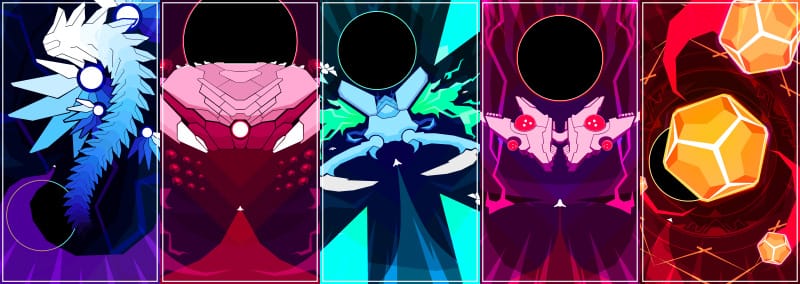
All of our efforts resulted in a gradual but very long slow burn. The game never reached the explosive viral growth you see in mega-hits like Slay the Spire, but it steadily grew throughout early access. This eventually got the attention of the Steam algorithms, which showed the game to more people and created a feedback loop. Our numbers would have been no big deal for most games, but for a company this small, it was. The game had begun to fund its own development. Since each update resulted in more growth, I started to feel less inclination to finish the game and instead a desire to make it as good as I thought it could be. And it seemed to be working.

I liked updating the game, and I felt like I had little reason to stop doing so in the lower-pressure-environment that is early access. So I grew it for years, adding modes like Wild Metamorphosis and other major features.
Climbing Content Mountain
Of course, the honey moon period of early development couldn't last forever, especially as the complexity started to mount, time dragged on, and I felt the pressure of player opinions weighing on me. I was still a relatively new programmer. As the game continued to expand, the technical problems were becoming too big to solve alone. Moreover, there were now so many upgrades that a large portion of my time became balance work. Since Nova Drift was initially so easy to support, I spent a long time thinking about where things had taken a turn. I narrowed it down to a few main reasons:
- An "everything works with everything" upgrade system meant that whenever I added an upgrade to the game, it compounded the challenge of balancing every upgrade that came before it. When we exceeded about 150 upgrades, things started to get problematic.
- Games with an endless mode are massively harder to balance than games with endings. For instance, in Hades, builds are considered viable if they can defeat the final boss. In Nova Drift, a build tends to be judged by how far it can push in waves. The higher the wave, the fewer builds are considered viable for it. This isn't great for build variety. Thankfully, this changed with 1.0, as Nova Drift now has an ending, with Endless Mode being optional.
- Architecture. While I did a good job of keeping the overall structure of the game simple and untangled, the code I wrote was sometimes error prone, hard to work with, and repetitious. It didn't help that Gamemaker's capabilities and features changed every few years. What can I say, I was self-taught.
Its hard to express how difficult solo game development is. Game development is already demanding, and doing it alone means you're performing a multitude of jobs at once, with a fraction of the resources. While I couldn't imagine doing anything else, I am very hesitant to ever recommend it, much in the same way someone might be hesitant to recommend boxing. You have to really want it because it is risky and it is punishing. Very few indie games even break even, let alone with tiny teams.
Despite all of this, I never doubted that it was right for me. While I admit that it working out involved a great deal of privilege and luck, I think what made it possible was certainty and obsession more than anything else. After I'd seen a video game, there was never a point when I didn't know I wanted to make one. I was always thinking about mechanics. I never stopped practicing the skill set, even before I was old enough to understand that what I was doing was practicing. Most game developer aspirants or professionals that I'd met didn't consider the risk of going solo to be worth it. If there are secret ingredients that make solo development work, I don't think its talent or intelligence, I think it's obsession, conviction, and tenacity.
Its interesting to think back on all of this now. Its been a decade since the start, and I realize that the project has now spanned a quarter of my life! It's grown much larger than my aspirations, and I attempted to do more alone than is reasonable or healthy. Over its course, I'd dragged myself back from the brink of burnout several times, and I can say with certainty that pushing through until the end was the hardest thing I have ever done. Still, it was consistently rewarding and always fascinating. Practicing so many skills at once kept me challenged, and as a result, exploded my potential as a person. I wouldn't have traded the experience for anything else.
The Discord Arc
It was very fortunate that I started speaking more frequently with a member of the community who had been there since the start, Ken "Ultraken" Miller. Ken is a veteran coder who has worked on many beloved AAA titles, but is most well known for his integral support on the Battlezone series. Ken began to help me over the years, patiently teaching me best practices, better scripting methods, good use of source control, tidy architecture, and helping out with particularly insidious bugs. Before long, he was optimizing the code base and submitting his own features and improvements. By the end of the project, Ken was responsible for many of the more elegant behaviors in the game, such as the construct swarm and Leviathan physics. Thinking back, he kept everything running smoothly whenever the pressure was on and anticipated problems before they manifested, several of which I wouldn't have known existed until it was too late. I don't know what I would have done without him.
Before I realized it, I wasn't really a solo developer anymore, and soon, many more helpers from the community become involved organically. In particular, a secretive person known only as "Lurk" began logging, organizing, and troubleshooting bugs with impressive precision and detail. He still does today. By the end, we'd found fantastic help with moderation, quality assurance, technical writing, and translators for 11 different languages. Amazing. A huge shout out to all of them, you are wonderful.
Every once in a while I meet a game developer who works mostly in a vacuum and I have to wonder why (or even how) they do it.

If I was technically unprepared, I was even less prepared to receive the level of criticism and attention the game was starting to generate. While I never doubted that I wanted to make Nova Drift, I didn't expect other people to actually care about it as much as they did. I thought it was just a cute little diversion that would be a stepping stone on my path to becoming a decent game designer. I made it for me... but other people had very strong opinions! I knew that this was inevitable with any game release, and on a good day I could handle it, but at times it felt like a torrent.
A trend I've noticed in creators, or maybe just in people, is that we tend to disregard praise and obsess over the negative. I think its difficult to maintain distance between ourselves and our projects. Creating is inherently very personal. After all, it's that we care deeply that allows our works to mean something.
Without a community manager, I had to learn to not take criticism personally, control my exposure to social media, and delegate volunteers when I needed to step away. It took about 5 years to become decent at it, but I got there. I am deeply grateful to those on my team that helped me manage.
Most of the feedback was still super positive, though. Sometimes alarmingly so (note their hours on record):
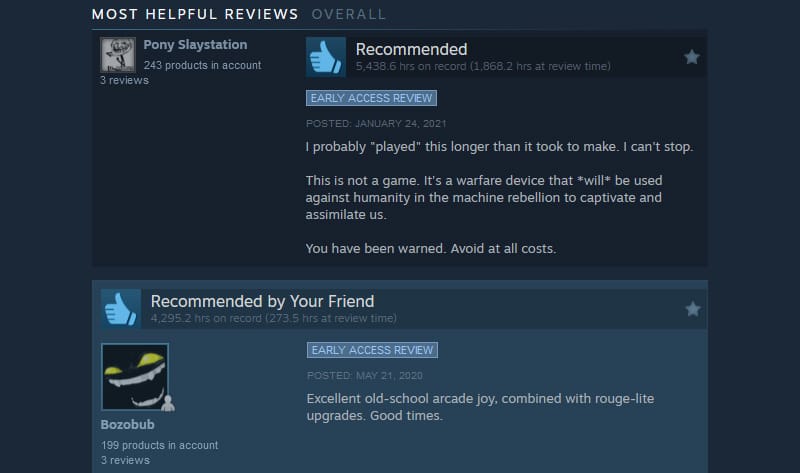
By 2020, our slow and steady iteration had resulted in a polished game long before I felt that it was ready to be released. We started getting big-name streamers playing, and Steam featured it in many Daily Deal events. Players were frequently surprised to find out that the game was not, in fact, "out yet". I started getting questioned about why the hell I hadn't released it yet. I always told people it was because the game didn't have an ending or a final boss yet, and there were still a few big improvements I wanted to make, anyway. But I also think it was because I was comfortable and a little afraid. I didn't know how to put it to rest.
The Rogue-Like Explosion of 2021
By 2021, I had planned one more major update to the game before I would begin wrapping it up, and we called it "Enemies 2.0". It was a total overhaul to enemy waves and behaviors. It also introduced more enemies and several alternate bosses. I wasn't sure if I should have done it. Players found it divisive, it took ages to develop, and it released in several parts. Each part ended up being the largest update we had ever made. If I hadn't done it, the game may have come out several years sooner, but I don't think it would have had a fraction of the replayability that it has now. In any case, during its development something interesting happened...
Rogue-likes, and then "Survivors-likes", suddenly exploded in popularity. After Vampire Survivors went viral, everybody started making them. You'd think that this would have buried Nova Drift, but the opposite started happening. You see, Steam is really good at showing players games that they might like, and it was of the distinct opinion that if you liked this funny vampire game, you might also like the silly spaceship game. And the same was true of many different fast-paced rogue-like games, all having each other recommended to each other by players and the Steam algorithms alike. The game exploded in popularity again, filling us with excitement and uncertainty. How long would this last? Were we waiting too long to release the game, should we rush to strike while the iron was hot? Was the market going to be oversaturated by the genre or was Nova Drift a unique enough take on it? It was a little unsettling to see so many games begin and end their development before Nova Drift was finished, several of which had taken distinct inspiration from our systems. We ended up sticking to the original plan, and I think that no matter what happens with launch, I'm glad that we did. I believe it was the right thing for the game.
Finishing, Finishing, Finishing
By now, Nova Drift was also exceeding 200 upgrades, almost all of which were compatible with each other. The complexity creep was real. Additionally, the metagame had become so mature that veterans players understood it far better than I did, and they were surviving farther in waves than I'd ever imagined. I started to accept that it had grown beyond my capacity to balance it. Our lead moderator, Soren Lily, saw me struggling with this and offered his help. Soren is a math enthusiast in the extreme, and has a deep understanding of Nova Drift along with a strong sense of game design. As the project neared its end, I came to lean on Soren more and more to help me untangle the ever-growing web of balance problems. We complimented each other's abilities fantastically, and ended up collaborating on most of the game's finishing touches. Soren was responsible for revitalizing several previously underwhelming mods near the end of the project, including Ataraxia, Sanctuary, Research, Void Slice, and Celestial Surge.
At the same time, I was becoming aware of how much less fluid the project had become. Far from the energetic pace of its alpha, the game became resistant to the smallest change. I expect this can be seen in any software old enough. Porting and localization multiply the scope of things for obvious reasons, but what isn't as clear is that a complex enough web of interlaced mechanics can mean that pulling a single thread cascades disastrously. Layering on more and more of an audience also increases the consequences of getting anything wrong. Not just because mistakes become costly, but because each one becomes a debate. It can all be disheartening, because experimentation is valuable, and making mistakes is an inexorable part of that process. This brings me back to earlier, when I mentioned how enjoyable a nascent game project is. For me, Nova Drift's inelasticity was a sign that it just needed to be completed. So, I allowed myself one more update to change a few more fun things, and then I would focus on the game's ending.
Turns out its really hard to finish a game. If you haven't done it before, you can think you're nearly done and still have years ahead of you, let alone how much work comes with then releasing the game. Hell, even veterans make the mistake. I thought I was "finishing" the game as early as the start of Enemies 2.0, and that ended up taking years.
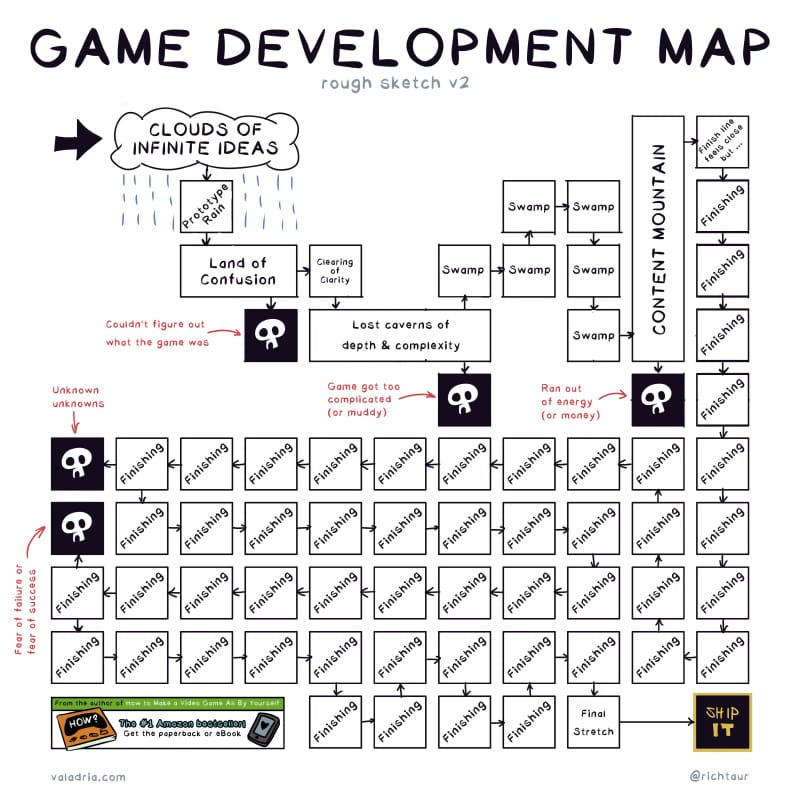
Nova Drift's Final Early Access Days
2024 has been a blur, but somehow we managed to get the final boss and the game's ending completed, slay 170 bugs, shine the game up, and slip in some really cool features at the 11th hour.
While we were wrapping it up, the rogue-like hype explosion did die down, and the ever-fickle gaze of the Steam Algorithms roamed onward. Nova Drift had officially existed in early access long enough to witness the resurgence and fall of its own genre. What I'm very curious to learn is whether a game in this position can get a second chance to go viral upon release. We've lined up as much hype as we could, and there's nothing to do now but wait and see what happens.
Now that it's complete, it doesn't even seem "real" to say that the game is done. I've been doing this for so long that I feel like I am a different person now than when I started, and I haven't dared to imagine a version of myself that wasn't entrenched in the project. I'm deeply appreciative that it all happened, and I am quite proud of it, but I am so, so ready to take a break and do something else. It was just all-consuming.
I'm anxious, but I'm also quite excited. I have entire notebooks full of concepts, and its clear to me now just how much harder I was working than I had to (but I'll save that for the postmortem). With more experience, better planning, clean architecture, and skillful allies, building something new should make me feel like I'd been running with weights on my ankles the whole time. But don't worry, if you're hoping for more, I'm sure I'll come back to Nova Drift in good time.
So... What's Next?
I'm still exploring options for Nova Drift, but there are a few things I would like to happen if launch goes well:
- Mobile ports for iOS and Android
- Major console ports
- A major DLC and/or update
Most players and our team seem agreed that the most valuable addition to the game would be a Daily Challenge mode, though we also receive a huge amount of requests for new Gear and Mod upgrades. Personally, I think that introducing new, versatile enemy types could be just as good for the longevity of the game.
Daily Challenge Mode?
Daily Challenge is a Challenge Mode that I hope to release in the future. It would allow players to compete against each other on a global leader board with specific game modifiers that change daily. Modifiers could include rule changes, buffs to specific player or enemy abilities, or feature all new mini-games. Everyone would play with the same game seed. Here are three example Daily Challenges that could appear:
- High Stakes: Players gain much more experience, take more damage from enemies, and cannot reroll upgrades.
- Cosmic Egg: Enemies target a Cosmic Egg, instead of you, which is always present, and can be pushed. If the egg dies, the game is over. The player has improved recovery.
- Purity: You begin with Ataraxia and the Gear of your choice, but you are limited to purchasing 7 mods. Ataraxia is much stronger than usual.
- Boss Rush: Compete for the best time as you face every boss in the game in succession, gaining several levels between each.
- Serpentine Drift: Play a version of the classic "Snake" game as an ever-growing Leviathan gobbling up points and tanking asteroids and comets.

While there is still plenty to do for Nova Drift, and I won't dismiss the possibility of a sequel one day, for now I'm excited to clear my mind and work on a brand new project. I've been tinkering with several prototypes throughout the year, and I think a few of them have fantastic potential. I'll be sharing them in the Nova Drift Discord when they're ready to show.
Don't want to miss my next game? Follow me!
On Twitter, BlueSky, Instagram, and TikTok

We've got quite an active discord with a very chill and inclusive community. The dev team is also pretty active there. We've got channels for #weekly-discussion, #ask-the-devs, and #feedback. I'm also quite proud of the #game-dev-help channel, which is a space for current and aspiring developers to learn and collaborate. So... come chat with us!
Want to help Nova Drift grow?
Steam Reviews really help! As a tiny operation, Nova Drift relies on its quality and reputation to sell, and fantastic reviews help people choose games with less exposure. Please do take a moment to fill out a short review, even if it's only a few words. It just might make a big difference.
Thank You
To everyone who has patiently awaited the release of Nova Drift throughout its long development, I appreciate you! It wouldn't be half the game it has become without its community, and I thank you for the opportunity to do what I love for a living. Good luck out there, in the cosmos!
Jeffrey (Chimeric)